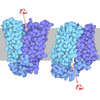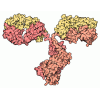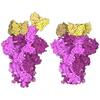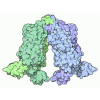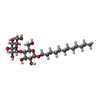+ Open data
Open data
- Basic information
Basic information
| Entry | Database: PDB / ID: 8qv6 | |||||||||
|---|---|---|---|---|---|---|---|---|---|---|
| Title | Structure of human SPNS2 in DDM | |||||||||
 Components Components |
| |||||||||
 Keywords Keywords | LIPID TRANSPORT / SLC TRANSPORTER / MEMBRANE PROTEIN / S1P / EXPORTER | |||||||||
| Function / homology |  Function and homology information Function and homology informationregulation of eye pigmentation / regulation of humoral immune response / regulation of T cell migration / sphingolipid transporter activity / lymphocyte migration / sphingolipid biosynthetic process / Sphingolipid de novo biosynthesis / sphingosine-1-phosphate receptor signaling pathway / lipid transport / T cell homeostasis ...regulation of eye pigmentation / regulation of humoral immune response / regulation of T cell migration / sphingolipid transporter activity / lymphocyte migration / sphingolipid biosynthetic process / Sphingolipid de novo biosynthesis / sphingosine-1-phosphate receptor signaling pathway / lipid transport / T cell homeostasis / B cell homeostasis / transmembrane transporter activity / lymph node development / sensory perception of sound / bone development / endosome membrane / membrane / plasma membrane Similarity search - Function | |||||||||
| Biological species |  Homo sapiens (human) Homo sapiens (human) | |||||||||
| Method | ELECTRON MICROSCOPY / single particle reconstruction / cryo EM / Resolution: 3.68 Å | |||||||||
 Authors Authors | Li, H.Z. / Pike, A.C.W. / McKinley, G. / Mukhopadhyay, S.M.M. / Moreau, C. / Scacioc, A. / Abrusci, P. / Borkowska, O. / Chalk, R. / Stefanic, S. ...Li, H.Z. / Pike, A.C.W. / McKinley, G. / Mukhopadhyay, S.M.M. / Moreau, C. / Scacioc, A. / Abrusci, P. / Borkowska, O. / Chalk, R. / Stefanic, S. / Burgess-Brown, N. / Duerr, K.L. / Sauer, D.B. | |||||||||
| Funding support |  Switzerland, Switzerland,  United Kingdom, 2items United Kingdom, 2items
| |||||||||
 Citation Citation |  Journal: Nat Commun / Year: 2025 Journal: Nat Commun / Year: 2025Title: Transport and inhibition of the sphingosine-1-phosphate exporter SPNS2. Authors: Huanyu Z Li / Ashley C W Pike / Yung-Ning Chang / Dheeraj Prakaash / Zuzana Gelova / Josefina Stanka / Christophe Moreau / Hannah C Scott / Frank Wunder / Gernot Wolf / Andreea Scacioc / ...Authors: Huanyu Z Li / Ashley C W Pike / Yung-Ning Chang / Dheeraj Prakaash / Zuzana Gelova / Josefina Stanka / Christophe Moreau / Hannah C Scott / Frank Wunder / Gernot Wolf / Andreea Scacioc / Gavin McKinley / Helena Batoulis / Shubhashish Mukhopadhyay / Andrea Garofoli / Adán Pinto-Fernández / Benedikt M Kessler / Nicola A Burgess-Brown / Saša Štefanić / Tabea Wiedmer / Katharina L Dürr / Vera Puetter / Alexander Ehrmann / Syma Khalid / Alvaro Ingles-Prieto / Giulio Superti-Furga / David B Sauer /     Abstract: Sphingosine-1-phosphate (S1P) is a signaling lysolipid critical to heart development, immunity, and hearing. Accordingly, mutations in the S1P transporter SPNS2 are associated with reduced white cell ...Sphingosine-1-phosphate (S1P) is a signaling lysolipid critical to heart development, immunity, and hearing. Accordingly, mutations in the S1P transporter SPNS2 are associated with reduced white cell count and hearing defects. SPNS2 also exports the S1P-mimicking FTY720-P (Fingolimod) and thereby is central to the pharmacokinetics of this drug when treating multiple sclerosis. Here, we use a combination of cryo-electron microscopy, immunofluorescence, in vitro binding and in vivo S1P export assays, and molecular dynamics simulations to probe SPNS2's substrate binding and transport. These results reveal the transporter's binding mode to its native substrate S1P, the therapeutic FTY720-P, and the reported SPNS2-targeting inhibitor 33p. Further capturing an inward-facing apo state, our structures illuminate the protein's mechanism for exchange between inward-facing and outward-facing conformations. Finally, using these structural, localization, and S1P transport results, we identify how pathogenic mutations ablate the protein's export activity and thereby lead to hearing loss. | |||||||||
| History |
|
- Structure visualization
Structure visualization
| Structure viewer | Molecule:  Molmil Molmil Jmol/JSmol Jmol/JSmol |
|---|
- Downloads & links
Downloads & links
- Download
Download
| PDBx/mmCIF format |  8qv6.cif.gz 8qv6.cif.gz | 127.5 KB | Display |  PDBx/mmCIF format PDBx/mmCIF format |
|---|---|---|---|---|
| PDB format |  pdb8qv6.ent.gz pdb8qv6.ent.gz | 78.4 KB | Display |  PDB format PDB format |
| PDBx/mmJSON format |  8qv6.json.gz 8qv6.json.gz | Tree view |  PDBx/mmJSON format PDBx/mmJSON format | |
| Others |  Other downloads Other downloads |
-Validation report
| Summary document |  8qv6_validation.pdf.gz 8qv6_validation.pdf.gz | 1.1 MB | Display |  wwPDB validaton report wwPDB validaton report |
|---|---|---|---|---|
| Full document |  8qv6_full_validation.pdf.gz 8qv6_full_validation.pdf.gz | 1.2 MB | Display | |
| Data in XML |  8qv6_validation.xml.gz 8qv6_validation.xml.gz | 30.6 KB | Display | |
| Data in CIF |  8qv6_validation.cif.gz 8qv6_validation.cif.gz | 43.3 KB | Display | |
| Arichive directory |  https://data.pdbj.org/pub/pdb/validation_reports/qv/8qv6 https://data.pdbj.org/pub/pdb/validation_reports/qv/8qv6 ftp://data.pdbj.org/pub/pdb/validation_reports/qv/8qv6 ftp://data.pdbj.org/pub/pdb/validation_reports/qv/8qv6 | HTTPS FTP |
-Related structure data
| Related structure data |  18668MC  8qv5C M: map data used to model this data C: citing same article ( |
|---|---|
| Similar structure data | Similarity search - Function & homology  F&H Search F&H Search |
- Links
Links
- Assembly
Assembly
| Deposited unit | 
|
|---|---|
| 1 |
|
- Components
Components
| #1: Protein | Mass: 58962.211 Da / Num. of mol.: 1 Source method: isolated from a genetically manipulated source Source: (gene. exp.)  Homo sapiens (human) / Gene: SPNS2 / Plasmid: pHTBV1.1-CTGFP-SIII-10H / Cell (production host): Expi293F / Production host: Homo sapiens (human) / Gene: SPNS2 / Plasmid: pHTBV1.1-CTGFP-SIII-10H / Cell (production host): Expi293F / Production host:  Homo sapiens (human) / References: UniProt: Q8IVW8 Homo sapiens (human) / References: UniProt: Q8IVW8 |
|---|---|
| #2: Antibody | Mass: 15674.475 Da / Num. of mol.: 1 Source method: isolated from a genetically manipulated source Source: (gene. exp.)   |
| #3: Sugar | ChemComp-LMT / |
| Has ligand of interest | Y |
| Has protein modification | Y |
-Experimental details
-Experiment
| Experiment | Method: ELECTRON MICROSCOPY |
|---|---|
| EM experiment | Aggregation state: PARTICLE / 3D reconstruction method: single particle reconstruction |
- Sample preparation
Sample preparation
| Component | Name: Complex of SPNS2 with nanobody D12 / Type: COMPLEX / Entity ID: #1-#2 / Source: RECOMBINANT | ||||||||||||||||
|---|---|---|---|---|---|---|---|---|---|---|---|---|---|---|---|---|---|
| Molecular weight | Value: 0.07453 ° / Experimental value: NO | ||||||||||||||||
| Source (natural) | Organism:  Homo sapiens (human) Homo sapiens (human) | ||||||||||||||||
| Source (recombinant) | Organism:  Homo sapiens (human) Homo sapiens (human) | ||||||||||||||||
| Buffer solution | pH: 7.5 / Details: 20mM HEPES pH 7.5, 150mM NaCl, 0.025% DDM | ||||||||||||||||
| Buffer component |
| ||||||||||||||||
| Specimen | Conc.: 14 mg/ml / Embedding applied: NO / Shadowing applied: NO / Staining applied: NO / Vitrification applied: YES / Details: SEC purified | ||||||||||||||||
| Specimen support | Grid material: GOLD / Grid mesh size: 300 divisions/in. / Grid type: Quantifoil R1.2/1.3 | ||||||||||||||||
| Vitrification | Instrument: FEI VITROBOT MARK IV / Cryogen name: ETHANE / Humidity: 100 % / Chamber temperature: 277 K |
- Electron microscopy imaging
Electron microscopy imaging
| Experimental equipment |  Model: Titan Krios / Image courtesy: FEI Company |
|---|---|
| Microscopy | Model: FEI TITAN KRIOS |
| Electron gun | Electron source:  FIELD EMISSION GUN / Accelerating voltage: 300 kV / Illumination mode: FLOOD BEAM FIELD EMISSION GUN / Accelerating voltage: 300 kV / Illumination mode: FLOOD BEAM |
| Electron lens | Mode: BRIGHT FIELD / Nominal magnification: 105000 X / Nominal defocus max: 2400 nm / Nominal defocus min: 1000 nm / C2 aperture diameter: 70 µm / Alignment procedure: COMA FREE |
| Specimen holder | Cryogen: NITROGEN / Specimen holder model: FEI TITAN KRIOS AUTOGRID HOLDER |
| Image recording | Average exposure time: 1.6 sec. / Electron dose: 25.4641 e/Å2 / Film or detector model: GATAN K3 (6k x 4k) / Num. of grids imaged: 1 / Num. of real images: 12014 / Details: eBIC Diamond Krios IV |
- Processing
Processing
| EM software |
| ||||||||||||||||||||||||||||||||||||||||||||||||
|---|---|---|---|---|---|---|---|---|---|---|---|---|---|---|---|---|---|---|---|---|---|---|---|---|---|---|---|---|---|---|---|---|---|---|---|---|---|---|---|---|---|---|---|---|---|---|---|---|---|
| CTF correction | Type: PHASE FLIPPING AND AMPLITUDE CORRECTION | ||||||||||||||||||||||||||||||||||||||||||||||||
| Particle selection | Num. of particles selected: 6672673 | ||||||||||||||||||||||||||||||||||||||||||||||||
| Symmetry | Point symmetry: C1 (asymmetric) | ||||||||||||||||||||||||||||||||||||||||||||||||
| 3D reconstruction | Resolution: 3.68 Å / Resolution method: FSC 0.143 CUT-OFF / Num. of particles: 246225 / Algorithm: FOURIER SPACE Details: Masked Local refinement in cryoSPARC with detergent micelle omitted Symmetry type: POINT | ||||||||||||||||||||||||||||||||||||||||||||||||
| Atomic model building | Protocol: OTHER / Space: REAL | ||||||||||||||||||||||||||||||||||||||||||||||||
| Atomic model building | Source name: AlphaFold / Type: in silico model | ||||||||||||||||||||||||||||||||||||||||||||||||
| Refinement | Cross valid method: NONE Stereochemistry target values: GeoStd + Monomer Library + CDL v1.2 | ||||||||||||||||||||||||||||||||||||||||||||||||
| Displacement parameters | Biso mean: 98.11 Å2 | ||||||||||||||||||||||||||||||||||||||||||||||||
| Refine LS restraints |
|
 Movie
Movie Controller
Controller




 PDBj
PDBj